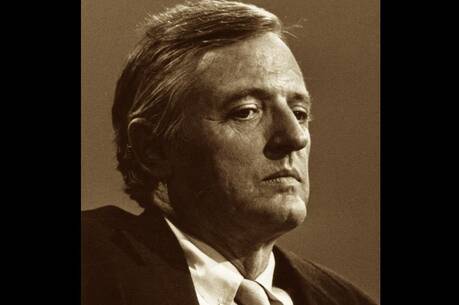Review: The ins and outs of a friendship with Graham Greene
Michael Mewshaw’s My Man in Antibes is an entertaining, moving memoir, spiced with intriguing literary anecdotes about his sometimes fraught friendship with Graham Greene. (It seems anyone who knew Greene had a fraught relationship with him.) It calls to mind two other books about Greene: The Man Within My Head, by Pico Iyer, and Greene on Capri: A Memoir, by Shirley Hazzard.
Mewshaw, whom the longtime NPR book commentator Alan Cheuse once called “the best novelist in America nobody knows,” mentions both of these books in his memoir. In writing about Iyer’s book, Mewshaw prefaces his remarks with a story of how he and his wife, Linda, honeymooned in Haiti because they had just read Greene’s The Comedians. Then he comments:
If following in Graham Greene’s footsteps sounds foolish, I’ll plead in self-defense that I had plenty of company. For decades, readers and religious zealots, defrocked priests, respected scholars, and admiring fellow authors had formed a procession behind Greene, like penitents on the Via Dolorosa.
In the same way, Mewshaw writes, Iyer, in The Man Within My Head, a play on the title of Greene’s first novel, “portrays Greene, whom Iyer had never met, as an uncanny mirror of his own past and a figure of prophesy for his future.”
Iyer’s book is a literary exploration of what Iyer has thought about Greene and his work, whereas Shirley Hazzard actually knew him during the summers Greene spent on Capri. She also mentions that “several of Graham’s friends from early years had gone through troubled relations with him—Graham not disliking his disruptive role. In most of his long associations, there were, I imagine, periods when his friends felt themselves heartily disliked.”
Graham Greene was a cantankerous and mirror-like man. All of these people following him on the Via Dolorosa, he trying to get away from them, ducking into brothels and bars along the way.
Hazzard wrote better than she knew. Mewshaw says that Greene did not always like having Hazzard around. “He told me,” Mewshaw writes, “that he found Hazzard’s pressure to socialize and trade intellectual gossip tiresome and oppressive. He lamented that she had almost ruined the island for him.”
Graham Greene, then, was a cantankerous and mirror-like man. All of these people following him on the Via Dolorosa, he trying to get away from them, ducking into brothels and bars along the way.
But why did they follow him? Because he was a great writer and an English Catholic convert who wrote about belief, doubt and betrayal. Having formed his artistic vision as the son of a headmaster in an English school, he never knew exactly where he stood with the other children or with his father. Whom should he be loyal to? Whom should he betray? All of which Greene describes in his first volume of autobiography, A Sort of Life.
Mewshaw had his own, more violent troubles growing up in Maryland in a poor Catholic family. Domestic and neighborhood violence marred his childhood, but he managed to claw his way out through his Catholic education. He then moved on to the University of Maryland and the University of Virginia, where he completed a doctorate in creative writing. From then on Mewshaw lived as a professor and writer who taught for many years in Texas but lived in Europe, mostly in Italy and France, in the summers.
Mewshaw had always admired Greene’s writing and, after badgering a priest who corresponded with Greene, got Greene’s address and wrote him a fan letter. He was so enamored of the author that, instead of accepting a Wallace Stegner Fellowship, which most writers would have died for, Mewshaw and his wife moved back to France in hopes of meeting Greene.
After receiving a brush-off first letter, Mewshaw tried again and, to his astonishment, Greene invited him and his wife over. Mewshaw’s description of their first meeting is memorable:
He [Greene] was then sixty-eight and a world historical figure. I was twenty-nine, and my initial impression was of a very old man, fragile, stoop-shouldered, with oysterish blue eyes that avoided mine. He was six foot two, an inch taller than I am, but appeared spindly beneath loose-fitting trousers and an untucked floral shirt. The Italian writer Mario Soldati, a friend of Greene’s, described him as having ‘a hurt, offended face, metaphorically bruised by events.’ Still, he retained an aura—or was this just my jangled nerves?—that made him imposing.
A cocktail or two relaxed everybody, and soon Greene was regaling the young couple with stories of meeting Ho Chi Minh in Vietnam—he’d had to fortify himself with “a few pipes of opium”—and his personal life with his mistress, Yvonne Cloetta. The two had met in Cameroon after Greene finished researching his novel, A Burnt-Out Case, in the Congo.
Greene surprised Mewshaw on their next meeting when he invited them to eat out at a restaurant, but could not himself drive a car. The world traveler who couldn’t drive a car! Many more contradictions followed, as Mewshaw learned of the ups and downs of friendship with Greene. After Mewshaw finally published a profile of Greene in The London Magazine, Greene exploded at him in a letter that, at least from Mewshaw’s point of view, rocked their friendship.
The passage of time smooths things over, but another strange thing happened as a result of Mewshaw’s profile. (This is where the juicy literary anecdotes come in.) A profile of Greene appeared in The New Yorker titled “The Dangerous Edge,” written by Penelope Gilliatt, the New Yorker film critic. As Mewshaw describes it, it “had [my] fingerprints all over it.”
Longtime NPR book commentator Alan Cheuse once Michael Mewshaw “the best novelist in America nobody knows."
When Mewshaw contacted the editor, Wallace Shawn, the latter offered him $2,000 to keep quiet about the situation. Gilliatt was in emotional distress, he said, and might kill herself if news leaked out. Later, Mewshaw read in Lillian Ross’s memoir (Ross was Shawn’s mistress) that this was the same reason Shawn gave her for not leaving his wife, who also would have killed herself. (Mewshaw also tells a couple of hilarious stories about the writer Anthony Burgess, whom Greene detested.)
Eventually Mewshaw settled back in the United States and found himself in a severe depression, rather like William Styron, whom he had known during his time at University of Virginia. But Mewshaw found that therapy and Prozac helped him out of it. He took advantage of these even though Greene had said he himself would never do so: “Cure the disease [and] I doubt a writer would remain.” Mewshaw risked it and didn’t publish a book for 10 years, but he produced a lot of freelance work.
There is not much about Catholicism per se in the book. As Mewshaw puts it, “[Greene’s] faith—how he felt about it, how he did or didn’t practice it—seemed to me a deeply private matter. I wouldn’t have challenged him any more than I would have quizzed him about his sex life.”
Mewshaw does discuss what is known of Greene’s relationship with Kim Philby, the British spy who worked for the Soviets, and doesn’t deny Greene said some reprehensible things in his defense. But he also, fittingly, says of Greene, “Wherever human lives, religious belief, or political freedom was at risk, Greene had traveled there to record the plight of the victims and reckon the body count.”
This article also appeared in print, under the headline “A Literary Pursuit,” in the March 2024, issue.










